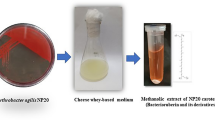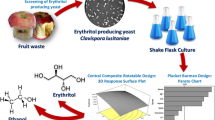Abstract
The present work investigated on carotenogenesis with high β-carotene content by a new isolated high-activity strain-producer Rhodotorula acheniorum mutant MRN in cheese whey ultrafiltrate. After a serial of UV, ethymethanesurfonate (EMS), and nitrosoguanidine (NTG) mutagenesis, a mutant named MRN of the red lactose-positive yeast strain R. acheniorum was obtained. Then, the effects of different growth medium factors on carotenoid production by this mutant at batch-scale level were identified and optimized by means of response surface methodology (RSM) in order to achieve high-level production of β-carotene. The optimum conditions required to achieve the highest level of β-carotene (262.12±1.01 mg/L) were determined as follows: whey ultrafiltrate (WU) lactose concentration 55 g/L, pH 5.85, ammonium sulfate concentration 3.5 g/L, temperature 23°C, and aeration rate 1.56 vvm. The medium optimization resulted in a 6.45-fold increase in volumetric production (262.12±1.01 mg/L) and a 4.62-fold increase in the cellular accumulation (10.69±0.19 mg/g) of β-carotene.
Similar content being viewed by others
References
Perera CO, Yen GM. Functional properties of carotenoids in human health. Int. J. Food. Prop. 10: 201–230 (2007)
Bhosale P, Bernstein PS. Microbial xanthophylls. Appl. Microbiol. Biot. 68: 445–455 (2005)
Bhosale P. Environmental and cultural stimulants in the production of carotenoids from microorganisms. Appl. Microbiol. Biot. 63: 351–361 (2004)
Razavi SH, Mosavi SM, Yeganeh HM, Marc I. Fatty acid and carotenoid production by Sporobolomyces ruberrimus when using technical glycerol and ammonium sulfate. J. Microbiol. Biotechn. 17: 1591–1597 (2007)
An GH, Jang BG, Cho MH. Cultivation of the carotenoid-hyperproducing mutant 2A2N of the red yeast Xanthophyllomyces dendrorhous (Phaffia rhodozyma) with molasses. J. Biosci. Bioeng. 92: 121–125 (2001)
Kvasnikov E, Grinberg T, Vaskivnjuk V, Nagornaja S, Sudenko V, Stelokova I. Yeasts synthesizing carotenoids. Izv. AN SSSR Biol.+ 4: 565–575 (1978)
Aksu Z, Eren AT. Carotenoids production by the yeast Rhodotorula mucilaginosa: Use of agricultural wastes as a carbon source. Process Biochem. 40: 2985–2991 (2005)
Libkind D, Broock M. Biomass and carotenoid pigment production by patagonian native yeasts. World J. Microb. Biot. 22: 687–692 (2006)
Libkind D, Gadanho M, van Broock MR, Sampaio JP. Sporidiobolus longiusculus sp. nov. and Sporobolomyces patagonicus sp. nov., novel yeasts of the Sporidiobolales isolated from aquatic environments in Patagonia, Argentina. Int. J. Syst. Evol. Micr. 55: 503–509 (2005)
Perrier V, Dubreucq E, Galzy P. Fatty acid and carotenoid composition of Rhodotorula strains. Arch. Microbiol. 164: 173–179 (1995)
Bhosale P, Gadre RV. Manipulation of temperature and illumination conditions for enhanced β-carotene production by mutant 32 of Rhodotorula glutinis. Lett. Appl. Microbiol. 34: 349–353 (2002)
Buzzini P, Martini A. Production of carotenoids by strains of Rhodotorula glutinis cultured in raw materials of agro-industrial origin. Bioresource Technol. 71: 41–44 (1999)
Simova ED, Frengova GI, Beshkova DM. Synthesis of carotenoids by Rhodotorula rubra GED8 co-cultured with yogurt starter cultures in whey ultrafiltrate. J. Ind. Microbiol. Biot. 31: 115–121 (2004)
Frengova GI, Simova ED, Pavlova K, Beshkova DM, Grigorova D. Formation of carotenoids by Rhodotorula glutinis in whey ultrafiltrate. Biotechnol. Bioeng. 44: 888–894 (1994)
Frengova GI, Simova ED, Beshkova DM. Effect of temperature changes on the production of yeast pigments co-cultivated with lactic acid in whey ultrafiltrate. Biotechnol. Lett. 17: 1001–1006 (1995)
Frengova GI, Simova ED, Beshkova DM. Carotenoid production by lactose-negative yeasts co-cultivated with lactic acid bacteria in whey ultrafiltrate. Z. Naturforsch C. 58: 562–567 (2003)
Simova ED, Frengova GI, Beshkova DM. Effect of aeration on the production of carotenoid pigments by Rhodotorula rubra-lactobacillus casei Subsp. casei co-cultures in whey ultrafiltrat. Z. Naturforsch. C. 58: 225–229 (2003)
Razavi SH, Fabrice B, Marc I. UV-HPLC/APCI-MS method for separation and identification of the carotenoids produced by Sporobolomyces ruberrimus H110. Iran. J. Chem. Chem. Eng. 25: 1–10 (2006)
Miller GL. Use of dinitrosalicylic acid reagent for determination of reducing sugar. Anal. Chem. 31: 426–430 (1959)
Liu Y, Wu JY. Optimization of cell growth and carotenoid production of Xanthophyllomyces dendrorhous through statistical experiment design. Biochem. Eng. J. 36: 182–189 (2007)
Matelli HL, Silva DI, Souza NO, Pomeroy D. Production of β-carotene by Rhodotorula strain grown on sugar cane juice. Biotechnol. Lett. 12: 207–208 (1990)
Buzzini P, Martini A, Gaetani M, Turchetti B, Pagnoni UM, Davoli P. Optimization of carotenoid production by Rhodotorula graminis DBVPG 7021 as a function of trace element concentration by means of response surface analysis. Enzyme Micro. Tech. 36: 687–692 (2005)
Girard P, Falconnier B, Bricout J, Vladescu B. β-Carotene producing mutants of Phaffia rhodozyma. Appl. Microbiol. Biot. 41: 183–191 (1994)
Mosqueda-Cano G, Gutierrez-Corona JF. Environmental and developmental regulation of carotenogenesis in the dimorphic fungus Mucor rouxii. Curr. Microbiol. 31: 141–145 (1995)
Orset SC, Young AJ. Exposure to low irradiances favors the synthesis of 9-cis β,β-carotene in Dunaliella salina (Teod.). Plant Physiol. 122: 609–618 (2000)
Ben-Amotz A. Effect of low temperature on the stereoisomer composition of β-carotene in the halotolerant alga Dunaliella bardawil (Chlorophyta). J. Phycol. 32: 272–275 (1996)
Shlomai P, Ben-Amotz A, Margalith P. The effect of veratrole on carotenoid biosynthesis by Phycomyces blakesleeanus. J. Appl. Bacteriol. 70: 166–168 (1991)
Choudhari SM, Ananthanarayan L, Singhal RS. Use of metabolic stimulators and inhibitors for enhanced production of β-carotene and lycopene by Blakeslea trispora NRRL 2895 and 2896. Bioresource Technol. 99: 3166–3173 (2008)
Author information
Authors and Affiliations
Corresponding author
Rights and permissions
About this article
Cite this article
Nasrabadi, M.R.N., Razavi, S.H. Optimization of β-carotene production by a mutant of the lactose-positive yeast Rhodotorula acheniorum from whey ultrafiltrate. Food Sci Biotechnol 20, 445–454 (2011). https://doi.org/10.1007/s10068-011-0062-1
Received:
Revised:
Accepted:
Published:
Issue Date:
DOI: https://doi.org/10.1007/s10068-011-0062-1




